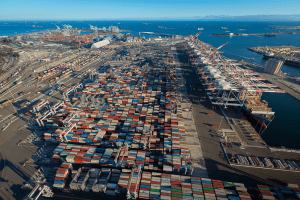BLOG
FCL vs LCL: Which Shipping Option Is Right for You?
- wanmeili
- 2025-11-10
Introduction
International shipping plays a pivotal role in the movement of goods across borders. It connects manufacturers, suppliers, and consumers, enabling businesses to expand their reach and tap into new markets. One of the most significant decisions businesses face when engaging with international shipping is selecting the right shipping method. Among the various shipping methods, two commonly used terms are FCL vs LCL Shipping (Full Container Load) and (Less than Container Load). Each method has its own advantages and disadvantages, making it essential for businesses to understand these concepts to make informed decisions for their shipping logistics.
What is FCL (Full Container Load)?
Definition and how it works
FCL, or Full Container Load, refers to a shipping method where a shipper occupies an entire shipping container with their cargo. In this arrangement, the shipment consists of a single cargo type or multiple goods that are consolidated to fill a single container. Once the container is loaded, it is sealed and transported directly to its destination without sharing space with other shipments. This method is typically utilized when the volume of goods is large enough to justify the use of an entire container, which can range from 20 to 40 feet in length.
When to use FCL
Opting for FCL is ideal in several scenarios:
Large Volumes: When the shipment is substantial enough to fill an entire container.
Homogeneous Cargo: When shipping similar items that can be packed together, minimizing the risk of damage during transit.
Direct Shipping Needs: When reduced transit times are a priority, as FCL shipments often have quicker processing and less handling compared to shared containers.
- Pros:
- Cost Efficiency for Large Shipments: For businesses with substantial volumes, FCL can be more cost-effective than using LCL (Less than Container Load), as the cost per unit decreases when utilizing an entire container.
- Faster Transit Times: FCL shipments typically experience fewer delays due to reduced handling and direct routing, ensuring that goods reach their destination more swiftly.
- Less Risk of Damage or Contamination: With a dedicated container, there is a significantly lower risk of damage or contamination from other shipments, providing greater security for the cargo.
- Cons:
- Higher Cost for Smaller Volumes: For shipments that do not fully utilize a container’s capacity, FCL can be less economical. Smaller volumes may pay for unused space, making LCL a more suitable option in such cases.
- Requires More Storage Space: Since FCL shipments necessitate a full container, businesses may need additional warehouse service or inventory management while waiting for the container to be filled, which can lead to increased overhead costs.
What is LCL (Less than Container Load)?
Definition and How It Works
LCL, or Less than Container Load, is a shipping method where multiple shipments from different shippers are consolidated into a single shipping container. This approach is suitable for smaller shipments that do not require an entire container for transport. In LCL shipping, individual cargo pieces are collected, grouped, and loaded together in one container, and once it arrives at its destination, the cargo is separated and delivered to respective recipients. This method is advantageous for those whose shipping needs do not justify the costs associated with a Full Container Load (FCL).
When to Use LCL
LCL is a suitable option in the following scenarios:
Small Shipments: When the volume of goods is insufficient to fill a standard shipping container, LCL allows businesses to ship smaller amounts economically.
Irregular Shipping Needs: Businesses with fluctuating or unpredictable shipping volumes can benefit from LCL, as it provides flexibility without the obligation of reserving an entire container.
Cost Sensitivity: For companies operating on tighter budgets or those new to international shipping, LCL can be a more affordable entry point.
Pros of LCL
Cost-Effective for Smaller Shipments: LCL provides an economical solution for businesses that need to ship smaller volumes without paying for a full container.
Flexible Volume Requirements: LCL allows for varying shipment sizes, enabling businesses to scale their shipping according to current demand without being tied to minimum capacity requirements.
Cons of LCL
Longer Transit Times Due to Consolidation: LCL shipments typically take longer to reach their destination. The need for consolidation and deconsolidation of cargo can prolong overall transit time compared to FCL shipments.
Higher Risk of Damage or Delays: Since LCL involves multiple shipments from different senders, there is an increased potential for handling damages or delays during loading, unloading, and transportation.
Additional Handling and Documentation: LCL shipments require more handling to manage the various cargo pieces and additional paperwork for each shipment, which can add complexity and time to the shipping process.
Key Factors to Consider When Choosing FCL vs LCL Shipping
- Shipment Size:
FCL (Full Container Load): Best for large shipments that can fill or nearly fill a container.
LCL (Less than Container Load): Suitable for smaller loads that do not require a full container.
- Cost Efficiency:
FCL: Generally more cost-effective per unit for larger shipments, despite higher initial costs.
LCL: Lower upfront costs but can incur additional fees for handling and consolidation.
- Transit Time:
FCL: Faster transit times as it goes directly to the destination without stops.
LCL: Longer transit times due to consolidation processes and multiple handling.
- Risk of Damage:
FCL: Lower risk of damage as the container is sealed and handled less frequently.
LCL: Higher risk due to multiple shipments sharing space, increasing the chance of cargo getting damaged.
- Inventory Management:
FCL: Better for businesses needing a predictable supply and consistent stock levels.
LCL: More flexible for businesses that require less frequent shipping or varied product volumes.
- Shipping Flexibility:
FCL: Less flexible since it requires filling or almost filling the entire container.
LCL: Offers greater flexibility for varying shipment sizes and frequencies.
- Customs Clearance:
FCL: Typically simpler customs process, as there is one consignee responsible for the entire shipment.
LCL: More complicated due to multiple consignors, requiring additional documentation and coordination.
- Destination and Accessibility:
FCL: Ideal for destinations with easy access to full container unloading facilities.
LCL: Useful for destinations where cargo can be consolidated from multiple shipments.
- Frequency of Shipments:
FCL: Preferable for businesses with a regular shipment schedule.
LCL: Better suited for businesses with infrequent or smaller shipment needs.
These factors will help businesses make informed decisions when choosing between FCL vs LCL shipping methods.
Cost Comparison: FCL vs LCL Shipping
Key Differentiator:
- FCL: You pay for the entire container, regardless of how full it is.
- LCL: You pay for the space your cargo occupies (per cubic meter or ton), plus shared costs.
FCL (Full Container Load)
- Primary Cost Structure:
- A single, all-inclusive rate for the entire container (e.g., 20′ or 40′).
- Cost is not dependent on the volume of your cargo, as long as it fits within the container’s limits.
- Cost Advantages:
- Lower Cost per Unit: For larger volumes (typically >15 CBM), the cost per cubic meter is significantly lower.
- Predictable Pricing: One flat fee makes budgeting and cost calculation simpler.
- Fewer Surcharges: Avoids LCL-specific handling fees like CFS (Container Freight Station) charges for stuffing and stripping.
- Potential Cost Disadvantages:
- Higher Absolute Cost: The total upfront cost is higher than a small LCL shipment.
- Inefficient for Small Volumes: Paying for an entire container when it’s half-full is financially wasteful.
- No Consolidation: Cannot combine goods from different suppliers without your own pre-consolidation.
- Ideal For: Shipments that fill at least 75-80% of a standard container (approx. 15 CBM for a 20′ container, 25-30 CBM for a 40′ container).
LCL (Less than Container Load)
- Primary Cost Structure:
- Freight Charge: Based on the greater of your cargo’s Volume (CBM) or Weight (Ton).
- Additional Fees: Includes charges for CFS Handling, Bill of Lading Fees, and potentially a premium for the service.
- Cost Advantages:
- Lower Absolute Cost: The initial freight cost for a small shipment is much lower.
- Pay-as-You-Use: You only pay for the space you need, improving cash flow.
- Built-in Consolidation: Perfect for combining smaller shipments from multiple suppliers into one container.
- Potential Cost Disadvantages:
- Higher Cost per Unit: The rate per CBM is higher than in FCL.
- Less Predictable: More variables and potential surcharges can make the total cost less transparent.
- Risk of Measurement Disputes: Final cost can change if the carrier’s measured volume/weight differs from your initial quote.
- Potential for Delays: Your cargo is tied to the consolidation schedule, which can lead to longer transit times.
- Ideal For: Shipments that are too small to justify an FCL (typically < 15 CBM).
Tips for Making the Right Choice
- Choose FCL if: Your cargo volume is high, you prioritize speed and security, and you want the lowest cost per unit.
- Choose LCL if: Your cargo volume is low, your priority is flexibility and consolidating multiple suppliers, and the lower upfront cost is critical.
Pro Tip: The cost crossover point is generally around 13-18 CBM. We recommend getting a detailed quote for both FCL and LCL for your specific cargo details to make the most cost-effective decision.
Conclusion
In summary, the choice between FCL vs LCL shipping is not one-size-fits-all; it is a strategic decision that hinges on a careful evaluation of your business’s specific needs.
The core trade-off is clear: FCL offers greater efficiency, speed, and security for large shipments, while LCL provides crucial flexibility and cost-effectiveness for smaller volumes. The most critical factor is often your shipment size, with the cost crossover point typically occurring around 13-18 CBM.
Ultimately, an informed decision requires balancing key factors such as:
- Total Cost vs. Cost per Unit
- Transit Time vs. Upfront Expense
- Cargo Security vs. Shipping Flexibility
There is no universally “better” option—only the right choice for your current shipment. By understanding the distinct advantages and trade-offs of FCL and LCL outlined in this article, businesses can optimize their supply chain, control costs, and ensure their goods are delivered in a manner that best supports their operational and financial goals. For the most accurate decision, we always recommend obtaining tailored quotes for both services based on your exact cargo details.



